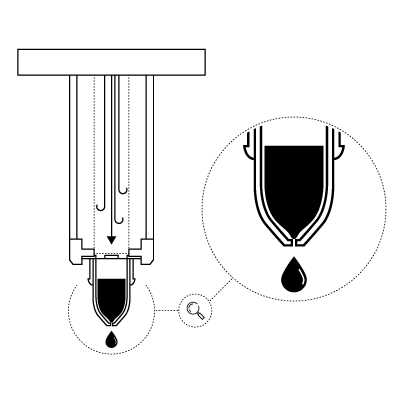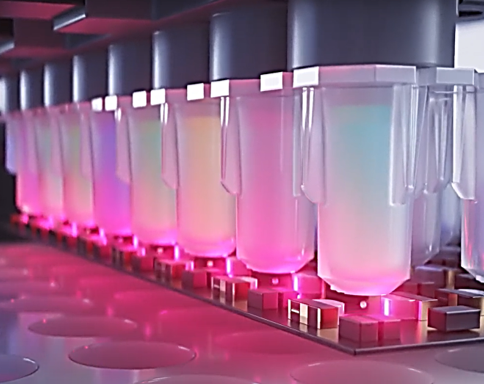Automated pipetting is an innovative technology that has revolutionized pipetting across research and clinical applications, including drug discovery, genomics, and diagnostics, by offering several advantages over manual pipetting1. Automated pipetting systems integrate robotic instruments with precision dispensing capabilities to accurately measure and transfer liquids, significantly reducing human error and increasing efficiency. Automated pipetting not only enhances reproducibility but also allows researchers to scale up sample numbers and scale down sample volumes for effective assay miniaturization2. Here, we will delve into automated pipetting systems, exploring their development, different formats, applications, and overall impact on laboratory practices.
How Has Pipetting Technology Evolved?
Pipetting has transformed considerably from the early 20th-century practice of mouth pipetting, which posed worrying health and contamination risks3, to the invention of the first mechanical air-displacement pipette in the late 1950s4. Manual air-displacement pipetting is still widely used today, along with multichannel and electronic pipettes that offer higher throughput and safety5. However, the past two decades have seen a surge in automated pipetting technology, revolutionizing precision, safety, and workflow efficiency in research1.
Looking ahead, automated pipetting is poised to advance research methodologies even further. The emergence of non-contact microfluidic techniques facilitates assay miniaturization, which reduces experimental scales while maintaining accuracy and reproducibility2,6. Moreover, the integration of automated pipetting systems with cloud-based software promises to elevate efficiency, flexibility, and collaboration in scientific research.
If you’re interested in learning more about the evolution of pipetting, check out The Evolution of Pipetting with Automation Technology.
What Types of Automated Pipetting Solutions Are Available, and Where Are They Used?
Automated and semi-automated pipetting solutions are revolutionizing laboratory workflows with their versatility and precision. This includes electronic pipettes with multichannel heads, which combine accuracy and ergonomic benefits with the efficiency of parallel sample processing – for example, the I.DOT Liquid Handler offers tipless, non-contact liquid handling, reducing costs and environmental impact while minimizing cross-contamination risks (Fig. 1). Liquid handling robots with manual control offer the precision of automation coupled with manual flexibility, allowing workflows to be optimized for specific experimental needs7. Finally, automated plate handling systems further enhance efficiency by managing microplate storage and transport for fully streamlined workflows8.

Figure 1. The advanced technology of the I.DOT Non-Contact Dispenser facilitates tipless, contact-free liquid transfers, ideal for saving costs and the environment!
These automated pipetting technologies are essential for high-throughput screening (HTS) applications, where they accelerate compound testing and enable assay miniaturization, critical for drug discovery and point-of-care testing2,9. In omics research, their precision dramatically reduces the risk of DNA and RNA contamination, ensuring accurate measurements and making the most of limited patient samples10,11.
To delve deeper into the types of automated pipetting solutions and their applications, read our recent article Exploring Semi-Automated Pipetting Solutions.
How Does Automated Pipetting Impact Lab Practices?
Robotic pipetting systems, particularly those with advanced features such as automated liquid class calibration and volume verification (Fig. 2), have substantially impacted laboratory practices by enhancing accuracy, efficiency, and safety. These systems offer a significant improvement over manual pipetting by reducing human error, which is crucial in sensitive workflows like omics research – for example, the I.DOT Non-Contact Dispenser achieves precise liquid transfers down to 8 nL, far surpassing manual capabilities12,13.

Figure 2. The I.DOT Non-Contact Dispenser is equipped with droplet detection sensors that provide integrated volume verification for unparalleled accuracy in liquid handling.
The automation of repetitive pipetting tasks not only minimizes errors but also frees up researchers for more complex work, enhancing lab productivity. Robotic pipetting enables the parallel processing of multiple samples, significantly increasing throughput, which is particularly beneficial in HTS pipelines14,15. Safety and ergonomics are greatly improved as these systems reduce the risk of repetitive strain injuries (RSI) and limit researchers' exposure to hazardous substances, providing a safer work environment, especially for labs that regularly work with pathogens or toxins7. Advancements in data integration and connectivity allow for seamless, intelligent workflows. For example, cloud-based platforms like the DISPENDIX Cloud Platform make it easier than ever for researchers to monitor and control their experiments remotely, fostering collaborative research efforts.
To explore the impact of automated pipetting on lab practices and hear our insights into how to select an optimal system for your lab, see The Impact of Robotic Pipetting on Lab Practices.
Conclusion
Automated pipetting has transformed laboratory practices by enhancing precision, efficiency, and safety across various applications, from drug discovery to clinical diagnostics. The evolution from manual to robotic pipetting systems has facilitated significant advancements in research methodologies, enabling high-throughput experiments, reducing human error, and fostering collaboration through cloud-based software integration.

Embrace the future of automated pipetting with the I.DOT Liquid Handler and book a demo today!
References
- Torres-Acosta MA, Lye GJ, Dikicioglu D. Automated liquid-handling operations for robust, resilient, and efficient bio-based laboratory practices. Biochem Eng J. 2022;188:108713. doi:10.1016/j.bej.2022.108713
- Pereira SAP, Dyson PJ, Saraiva MLMFS. Miniaturized technologies for high-throughput drug screening enzymatic assays and diagnostics – A review. TrAC Trends Anal Chem. 2020;126:115862. doi:10.1016/j.trac.2020.115862
- DeLuca C, Gioeli RP, Yarm SD. Elimination of mouth pipetting in the tissue culture laboratory. J Tissue Cult Methods. 1980;6(1):21-23. doi:10.1007/BF01665900
- Klingenberg M. When a common problem meets an ingenious mind: The invention of the modern micropipette. EMBO Rep. 2005;6(9):797-800. doi:10.1038/sj.embor.7400520
- Center of Excellence in Genomic Medicine Research, King Abdulaziz University, Jeddah-21589, Kingdom of Saudi Arabia, Pushparaj P. Revisiting the Micropipetting Techniques in Biomedical Sciences: A Fundamental Prerequisite in Good Laboratory Practice. Bioinformation. 2020;16(1):8-12. doi:10.6026/97320630016008
- Ortseifen V, Viefhues M, Wobbe L, Grünberger A. Microfluidics for Biotechnology: Bridging Gaps to Foster Microfluidic Applications. Front Bioeng Biotechnol. 2020;8:589074. doi:10.3389/fbioe.2020.589074
- Miller KWP, Grossman N, Haviernik P, et al. A Semi-Automated Tuberculosis Testing Workflow Reduces Manual Hazardous Sample Handling and Hands-On Time: A Proof-of-Concept Study. SLAS Technol. 2020;25(3):253-257. doi:10.1177/2472630319884519
- Markert S, Joeris K. Development of an automated, multiwell plate based screening system for suspension cell culture. BMC Proc. 2011;5(S8):O9, 1753-6561-5-S8-O9. doi:10.1186/1753-6561-5-S8-O9
- Carstens C, Elbracht R, Gärtner C, Becker H. Opportunities and limits of cell-based assay miniaturization in drug discovery. Expert Opin Drug Discov. 2010;5(7):673-679. doi:10.1517/17460441.2010.488264
- Tegally H, San JE, Giandhari J, De Oliveira T. Unlocking the efficiency of genomics laboratories with robotic liquid-handling. BMC Genomics. 2020;21(1):729. doi:10.1186/s12864-020-07137-1
- Christler A, Felföldi E, Mosor M, et al. Semi-automation of process analytics reduces operator effect. Bioprocess Biosyst Eng. 2020;43(5):753-764. doi:10.1007/s00449-019-02254-y
- Guan XL, Chang DPS, Mok ZX, Lee B. Assessing variations in manual pipetting: An under-investigated requirement of good laboratory practice. J Mass Spectrom Adv Clin Lab. 2023;30:25-29. doi:10.1016/j.jmsacl.2023.09.001
- Socea JN, Stone VN, Qian X, Gibbs PL, Levinson KJ. Implementing laboratory automation for next-generation sequencing: benefits and challenges for library preparation. Front Public Health. 2023;11:1195581. doi:10.3389/fpubh.2023.1195581
- Schneider G. Automating drug discovery. Nat Rev Drug Discov. 2018;17(2):97-113. doi:10.1038/nrd.2017.232
- Roy A. High-Throughput Screening (HTS) Technology. In: Offermanns S, Rosenthal W, eds. Encyclopedia of Molecular Pharmacology. Springer International Publishing; 2021:787-799. doi:10.1007/978-3-030-57401-7_73